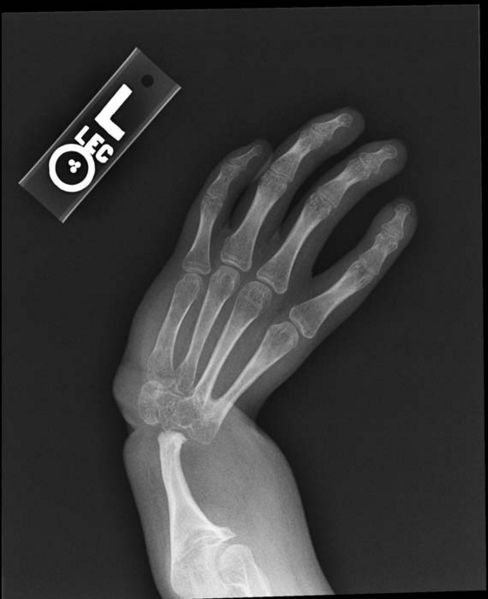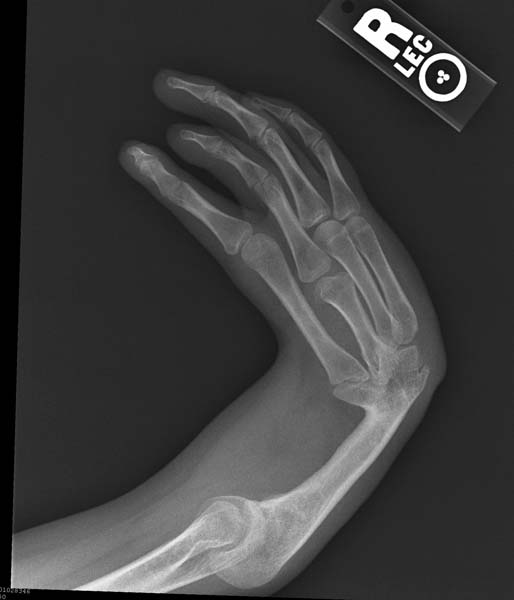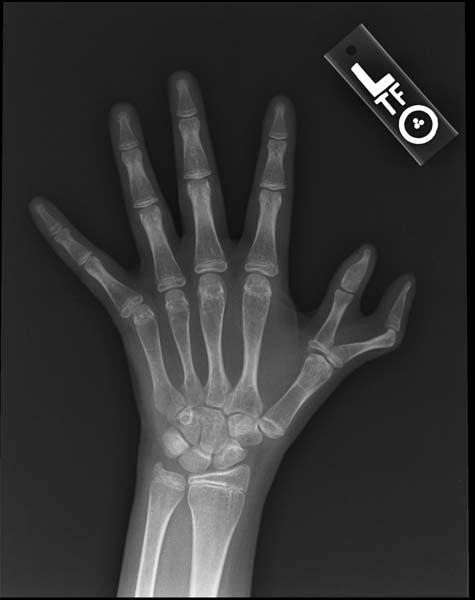Fanconi anemia x ray
|
Fanconi anemia Microchapters |
|
Diagnosis |
|---|
|
Treatment |
|
Case Studies |
|
Fanconi anemia x ray On the Web |
|
American Roentgen Ray Society Images of Fanconi anemia x ray |
Editor-In-Chief: C. Michael Gibson, M.S., M.D. [1]; Associate Editor(s)-in-Chief:
Overview
Although non-specific, these are one of the best described features and include:
- radial ray anomalies: including absent thumb
- triphalangeal thumb
Skeletal survey
Perform a skeletal survey to identify all developmental defects involving bone. Keep in mind that radiation doses should be limited in patients with Fanconi anemia. Care should be taken to avoid unnecessary radiation in patients with a cancer predisposition.
X Ray
- Many of the congenital anomalies can be detected on imaging studies. These include:
- Growth disturbances: Intrauterine growth retardation, short stature, delayed ossification.
- Central nervous system: Hydrocephalus, single ventricle, absent septum pellucidum/corpus callosum, vascular malformations, moyamoya, Chiari malformations/absent septum pellucidum/corpus callosum.
- Skull: Microcephaly, craniosynostosis, micrognathia, frontal bossing, small or absent external auditory canal, absent tympanic membrane, microtia, fused ossicles.
- Spine: Spina bifida, Klippel-Feil anomaly, vertebral body anomalies, sacral agenesis or hypoplasia, kyphosis, scoliosis.
- Radial ray anomalies: Thenar hypoplasia; dislocation of the radial head; radioulnar synostosis; absence or hypoplasia of the radius, scaphoid, trapezium, and/or thumb; floating thumb; bifid thumb; digitalized thumb; and abnormal thumb placement.
- Extremities (other): Brachydactyly, arachnodactyly clubfoot, dysplastic or absent ulna, humeral abnormalities, absent clavicles, Sprengel deformity, congenital hip dysplasia/dislocation, Legg-Calve-Perthes disease, leg length discrepancy, soft-tissue syndactylism of the toes, metatarsus varus, medial deviation of the toes, hammer toes.
- Gastrointestinal: Esophageal atresia, tracheoesophageal fistula, duodenal atresia, duodenal web, malrotation, foregut duplication cyst, anal atresia. Biliary atresia, annular pancreas.
- Renal anomalies: Renal aplasia, horseshoe kidney, low-lying kidney(s), renal ectopy, hydronephrosis, hydroureter, urethral stenosis, reflux.
- Genital anomalies: Hypogenitalism, cryptorchidism, hypospadias, bicornate uterus, aplasia or hypoplasia of vagina and uterus, atresia of vagina, hypoplasic uterus, hypoplastic/absent ovary.
- Cardiopulmonary: Patent ductus arteriosis, ventricular septal defect, pulmonic or aortic stenosis, coarcation of the aorta, double aortic arch, cardiomyopathy, tetralogy of Fallot, pulmonary atresia.
- Osteoporosis:
OR
- There are no x-ray findings associated with [disease name]. However, an x-ray may be helpful in the diagnosis of complications of [disease name], which include:
- [Complication 1]
- [Complication 2]
Patient#1
Patient #2


